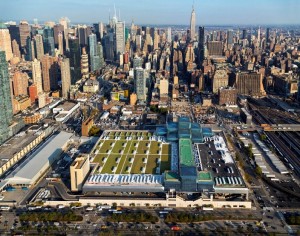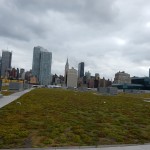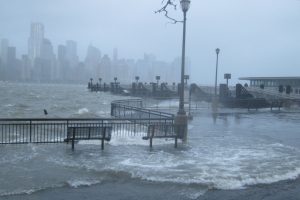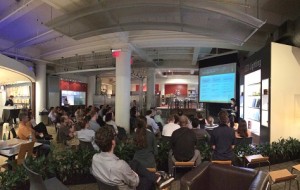Tag: stormwater
January 27, 2018
October Tour Recap: Newtown Creek Wastewater Treatment Plant
by Noah Siegel Have you ever wondered what happens to the water you use after washing the dishes, taking a shower, or flushing the toilet? GreenHomeNYC visited the Newtown Creek Wastewater Treatment Plant in Greenpoint, Brooklyn to learn how the NYC Department of Environmental Protection (DEP) sustainably handles wastewater treatment. Our tour was led by LaToya Anderson, the Science and Environmental Protection Educator for the NYC DEP.
As the largest of NYC’s 14 wastewater treatment facilities, Newtown Creek handles an impressive 310 million gallons of wastewater every day, and up to 620 million on a rainy day. As we approached the site, the first thing we noticed were the glistening, futuristic digester “eggs”. Since 2010, these alien-esque digesters have become an iconic piece of the Brooklyn cityscape, especially when illuminated with bright blue LEDs in the evening.
Anaerobic Digestion
Inside the digesters, a biological process called “anaerobic digestion” takes place. Bacteria breaks down “sludge”, the organic material removed from our sewage. For this process to take place, the digesters are kept at 98°F and are completely sealed to create an oxygen-free environment. In total, these digesters can hold 24 million gallons of sludge at any given time.
(more…)
Have you ever wondered what happens to the water you use after washing the dishes, taking a shower, or flushing the toilet? GreenHomeNYC visited the Newtown Creek Wastewater Treatment Plant in Greenpoint, Brooklyn to learn how the NYC Department of Environmental Protection (DEP) sustainably handles wastewater treatment. Our tour was led by LaToya Anderson, the Science and Environmental Protection Educator for the NYC DEP.
As the largest of NYC’s 14 wastewater treatment facilities, Newtown Creek handles an impressive 310 million gallons of wastewater every day, and up to 620 million on a rainy day. As we approached the site, the first thing we noticed were the glistening, futuristic digester “eggs”. Since 2010, these alien-esque digesters have become an iconic piece of the Brooklyn cityscape, especially when illuminated with bright blue LEDs in the evening.
Anaerobic Digestion
Inside the digesters, a biological process called “anaerobic digestion” takes place. Bacteria breaks down “sludge”, the organic material removed from our sewage. For this process to take place, the digesters are kept at 98°F and are completely sealed to create an oxygen-free environment. In total, these digesters can hold 24 million gallons of sludge at any given time.
(more…)
November 28, 2017
November Green Building Tour Recap: Building Towards Resilience
by Brigitta Berze It’s been five years since Hurricane Sandy hit the East Coast, leaving a trail of destruction in the New York area. During the “Building Towards Resilience” Green Building Tours event, Henry Gifford of Chris Benedict R.A., led a tour through 327 and 334 East 8th Street – two Lower East Side buildings that were affected by the hurricane – providing a firsthand look at renovations that were made in the aftermath of the natural disaster.
It’s been five years since Hurricane Sandy hit the East Coast, leaving a trail of destruction in the New York area. During the “Building Towards Resilience” Green Building Tours event, Henry Gifford of Chris Benedict R.A., led a tour through 327 and 334 East 8th Street – two Lower East Side buildings that were affected by the hurricane – providing a firsthand look at renovations that were made in the aftermath of the natural disaster.
The tour began in the noisy basement of 334 East 8th Street, with a description of the damage after Hurricane Sandy, including the conditions that the workers had to endure. The elevator in this building is not counteracted by weights to lift the elevator car, but instead uses oil mixed with other chemicals in a hydraulic elevator machine. As the water rose to about six feet above the basement floor, the oil and chemicals mixed with the flood waters, creating a hazardous condition for workers. The slippery mix of oil, water and sewage caused the superintendant to get a foot infection that landed him in the hospital for three days.
(more…)May 30, 2017
Rainwater Harvest: A Solution to Our Water Crisis?
by Tamanna Mohapatra Anyone following the climate change debate is acutely aware of a few facts – the rising temperature of our earth, melting glaciers around the world, the lack of urgency to take action on the part of most world leaders, and last but not the least, the alarming depletion of water resources. According to the United Nations, “Water scarcity affects more than 40 per cent of the global population and is projected to rise. It is estimated that 783 million people do not have access to clean water and over 1.7 billion people are currently living in river basins where water use exceeds recharge.”
But people who know these facts also know that we can still solve our climate change problems, and that in most cases, it’s not a matter of scarcity but a matter of good management. According to the World Water Council, “there is a water crisis today. But the crisis is not about having too little water to satisfy our needs. It is a crisis of managing water so badly that billions of people – and the environment – suffer badly.”
(more…)
Anyone following the climate change debate is acutely aware of a few facts – the rising temperature of our earth, melting glaciers around the world, the lack of urgency to take action on the part of most world leaders, and last but not the least, the alarming depletion of water resources. According to the United Nations, “Water scarcity affects more than 40 per cent of the global population and is projected to rise. It is estimated that 783 million people do not have access to clean water and over 1.7 billion people are currently living in river basins where water use exceeds recharge.”
But people who know these facts also know that we can still solve our climate change problems, and that in most cases, it’s not a matter of scarcity but a matter of good management. According to the World Water Council, “there is a water crisis today. But the crisis is not about having too little water to satisfy our needs. It is a crisis of managing water so badly that billions of people – and the environment – suffer badly.”
(more…)
February 25, 2017
Sea Change: Sea Level Rise and New York City’s Resilience Efforts
by Samantha Yost In 2012, Superstorm Sandy was a wake-up call to New York City, signaling that the demands of a changing climate are the “new normal,” and the city needs all hands on deck to mitigate the damage of future storms. Although much of the damage caused by flooding events occur during storms, sea level rise is very much a wildcard; higher water levels stack with coastal flooding, increasing the amount of damage that may result. How much sea level rise can we expect in the next century? Nobody can say for certain how much global sea level rise we can expect in the next century. Changing sea levels are caused by two main factors: the melting of continental glaciers (most significantly in Greenland and Antarctica), and thermal expansion. Warmer objects expand, and a warmer climate means that our oceans will physically expand in size. (more…)January 27, 2017
{Green Careers} January 2017 Recap: Resilience and Stormwater Management
by Samantha Yost On January 10, GreenHomeNYC hosted three professionals in the field of resilience and stormwater management at the offices of the Community Preservation Corporation, which itself has done significant post-Sandy recovery work in some of the most vulnerable and heavily impacted communities. This Sustainable Career Tracks event attracted a diverse crowd eager to get career advice from our panel of experts. Mark Ginsberg, Principal at Curtis + Ginsberg Architects, LLP Mark Ginsberg is a familiar face in the resilience community, having spoken on several previous panels about the work his firm has done with new construction and renovations on buildings in the flood plain. Mark is also co-author of Enterprise’s manual Ready to Respond, Strategies for Multifamily Building Resilience, which seeks to give information to owners of multifamily buildings on how to protect their properties and residents in case of an emergency. He spoke about the Arverne East project that his firm has designed in the Rockaways, an area in the flood plain that has endured heavy damage during Superstorm Sandy. (more…)December 1, 2016
Building Energy NYC: Sustainable Solutions for New York City
by Kimberly Stempien Imagine a city with clean air, solar energy, plenty of pedestrian spaces and no cars. It’s not at all far-off; these are all on the agenda for New York City in coming years. In fact, some of the projects are already in progress. The Northeast Sustainable Energy Association held their annual Building Energy NYC conference on November 3, bringing together leaders in energy, building maintenance, real estate, policy, product, and new technologies. Many topics were discussed, but three of the main takeaways were long term planning, regional-district planning, and enhanced resiliency for the city of New York. In a talk by Jenna Tatum, Kate Gouin, Benjamin Mandel and John Lee from the NYC Mayor’s Office of Sustainability, the focus was on 80×50, the de Blasio administration’s commitment to reduce GHG emissions 80% from 2005 levels by 2050 (80×50). NYC’s Sustainability 80X50 plan states, “It is the level the UN projects is necessary to avert the most disastrous impacts of climate change.” The plan is essentially a roadmap that is broken into four areas of focus: Buildings, Energy Supply, Waste, and Transportation, with comprehensive reporting and modeling done for each category. Following are the four main takeaways of the plan’s goals in each sector. (more…)January 28, 2016
February Forum: Water Management in the City
Water is a central aspect of all of our lives, and yet the complexities we face with managing it in a city of nearly 8.5 million people, often fly under the radar. Constantly supplying it, managing demand, keeping it clean, protecting ourselves from it (i.e. sewage, storms, sea level rise, etc), using it more efficiently and also teaching people about it, are all critically important to keeping such a massive city running. At a time where one American city is facing a major health crisis due to water contamination, we want to examine what is being done in our own city to keep us healthy and safe, and what we can do to support that. For our February Forum, we will hear about how the City of New York manages water in the present and the plans being pursued for the future.
Date: Wednesday, February 17, 2016 Time: 6:30-8:00pm Place: Hafele America Co., 25 East 26th Street, New York, NY 10010
To speak on this topic we are bringing in:
Vlada Kenniff, Managing Director of the Demand Management and Resiliency group in the New York City Department of Environmental Protection. She manages a portfolio of sustainability and resiliency projects that cover a Water Demand Management Program, Climate Resiliency Program, and Green Infrastructure Projects. In the last five years with the agency, Vlada worked on the Sustainable Storm Water Management Plan, Managed the NYC Green Infrastructure Plan, and the Water Demand Management Plan
Michele Moore, Senior Advisor to the VP of Disaster Recovery at the New York City Housing Authority (NYCHA). She oversees over $3 billion in disaster recovery funds to repair and protect from future storms, over 33 NYCHA developments severely damaged during Superstorm Sandy. Looking at these 33 developments as campuses, Michele is part of a team working to change the way water is managed on these sites through NYCHA’s Stormwater Management Through Placemaking Initiative. Recently NYCHA was awarded funding for this initiative for our Sandy damaged developments on the Lower East Side of Manhattan through the National Disaster Resiliency Competition, sponsored by the U.S. Department of Housing and Urban Development.
November 2, 2015
Javits Center: The Largest Green Roof in NYC
by Shari Baitcher In New York, a city with one of the highest population densities in the U.S., every square foot is valuable. In recent years more thought has been given to the space on top of buildings. With 840,000 square feet of exhibition space occupying 6 city blocks, the Jacob K. Javits Convention Center has recently introduced the second largest green roof in the United States.
Rick Brown, Chief Engineer for the Javits Center, exuded passion for the recently implemented sustainability project as he took GreenHomeNYC volunteers and community members behind the scenes of the convention center. We stopped at the IT office where he explained how they capture the heat generated by the computers and servers to help offset the building’s heating demand. Sensors have been installed all over the building to monitor efficiency, revealing a 26% reduction in energy consumption since the renovations have been completed. Additionally, water consumption has been reduced by 2.9 million gallons. Efficiency measures such as these contribute towards the Javits Center’s goal of earning LEED Silver certification.
(more…)
square foot is valuable. In recent years more thought has been given to the space on top of buildings. With 840,000 square feet of exhibition space occupying 6 city blocks, the Jacob K. Javits Convention Center has recently introduced the second largest green roof in the United States.
Rick Brown, Chief Engineer for the Javits Center, exuded passion for the recently implemented sustainability project as he took GreenHomeNYC volunteers and community members behind the scenes of the convention center. We stopped at the IT office where he explained how they capture the heat generated by the computers and servers to help offset the building’s heating demand. Sensors have been installed all over the building to monitor efficiency, revealing a 26% reduction in energy consumption since the renovations have been completed. Additionally, water consumption has been reduced by 2.9 million gallons. Efficiency measures such as these contribute towards the Javits Center’s goal of earning LEED Silver certification.
(more…)
October 16, 2015
October Green Building Tour: Jacob Javits Center Green Roof
Join GreenHomeNYC for a special tour of the green roof of New York City’s Jacob Javits Center on Friday, October 23rd at 2pm The Jacob Javits Convention Center is home to the second largest green roof on a single, free-standing building in the U.S. and the largest in NYC! The green roof was completed in October 2014 and is 297,000 sqft. It prevents approximately 6.8 million gallons of stormwater run-off annually. The roof features 14 different varieties of Sedum plants grown on a regional production farm in upstate New York. Read more about the roof from the designers.
The Jacob Javits Convention Center is home to the second largest green roof on a single, free-standing building in the U.S. and the largest in NYC! The green roof was completed in October 2014 and is 297,000 sqft. It prevents approximately 6.8 million gallons of stormwater run-off annually. The roof features 14 different varieties of Sedum plants grown on a regional production farm in upstate New York. Read more about the roof from the designers.
July 29, 2011
Green Career Profile: Joseph Schaffer
Joseph Schaffer, PE, Green Environmental Associates, Metuchen, NJ What did your life look like before you started Green Environmental Associates?
Prior to deciding to work for myself, I was doing site civil engineering for commercial developers, projects like big box retail and mega subdivisions. My work has always revolved around design and engineering in land development. This type of work requires the ability to balance hardcore science and site specific conditions in the field with fuzzier disciplines, like urban planning theory, construction tolerance, and environmental concerns.
Describe your “Eureka!” moment that shaped your decision to start your own company.
To make a real impact, I believe that a professional must really understand the existing approach to development and work to change that approach from the inside the system. However, that desire for change must be integrated into the mission of the company. I met my business partners while working on a corporate advisory board and we found that common ground. So we started Green Environmental Associates to reflect a mission of bringing change from the inside. We’re not just consultants, but partners in shaping our client’s future.
(more…)
What did your life look like before you started Green Environmental Associates?
Prior to deciding to work for myself, I was doing site civil engineering for commercial developers, projects like big box retail and mega subdivisions. My work has always revolved around design and engineering in land development. This type of work requires the ability to balance hardcore science and site specific conditions in the field with fuzzier disciplines, like urban planning theory, construction tolerance, and environmental concerns.
Describe your “Eureka!” moment that shaped your decision to start your own company.
To make a real impact, I believe that a professional must really understand the existing approach to development and work to change that approach from the inside the system. However, that desire for change must be integrated into the mission of the company. I met my business partners while working on a corporate advisory board and we found that common ground. So we started Green Environmental Associates to reflect a mission of bringing change from the inside. We’re not just consultants, but partners in shaping our client’s future.
(more…)




